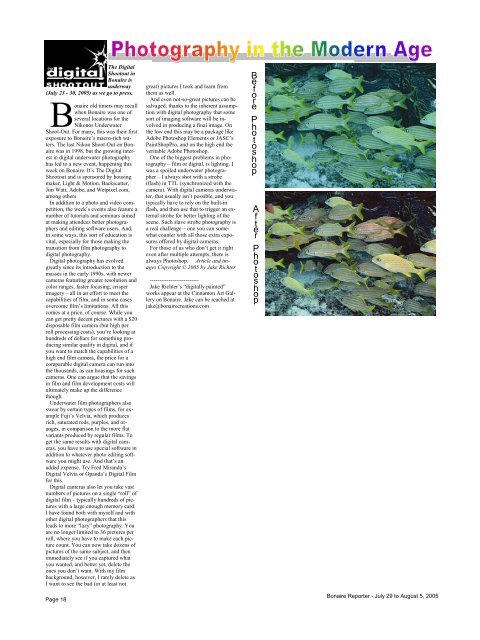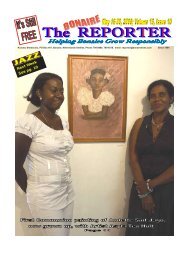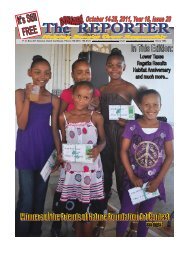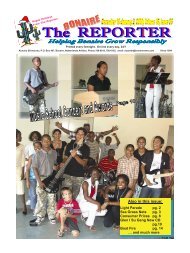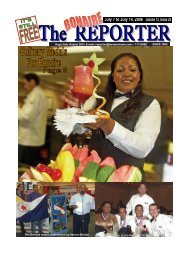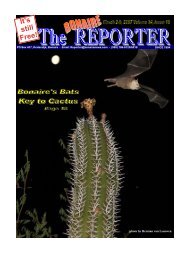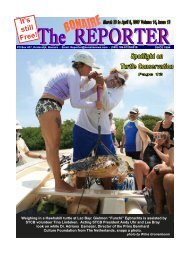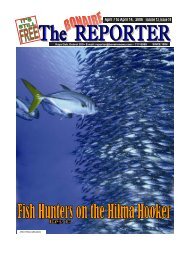July 29 to August 5, 2005 Volume 12, Issue 29 - The Bonaire Reporter
July 29 to August 5, 2005 Volume 12, Issue 29 - The Bonaire Reporter
July 29 to August 5, 2005 Volume 12, Issue 29 - The Bonaire Reporter
Create successful ePaper yourself
Turn your PDF publications into a flip-book with our unique Google optimized e-Paper software.
<strong>The</strong> Digital<br />
Shoo<strong>to</strong>ut in<br />
<strong>Bonaire</strong> is<br />
underway<br />
(<strong>July</strong> 23 - 30, <strong>2005</strong>) as we go <strong>to</strong> press.<br />
B<br />
onaire old timers may recall<br />
when <strong>Bonaire</strong> was one of<br />
several locations for the<br />
Nikonos Underwater<br />
Shoot-Out. For many, this was their first<br />
exposure <strong>to</strong> <strong>Bonaire</strong>’s macro-rich waters.<br />
<strong>The</strong> last Nikon Shoot-Out on <strong>Bonaire</strong><br />
was in 1998, but the growing interest<br />
in digital underwater pho<strong>to</strong>graphy<br />
has led <strong>to</strong> a new event, happening this<br />
week on <strong>Bonaire</strong>. It’s <strong>The</strong> Digital<br />
Shoo<strong>to</strong>ut and is sponsored by housing<br />
maker, Light & Motion, Backscatter,<br />
Jim Watt, Adobe, and Wetpixel.com,<br />
among others.<br />
In addition <strong>to</strong> a pho<strong>to</strong> and video competition,<br />
the week’s events also feature a<br />
number of tu<strong>to</strong>rials and seminars aimed<br />
at making attendees better pho<strong>to</strong>graphers<br />
and editing software users. And,<br />
in some ways, this sort of education is<br />
vital, especially for those making the<br />
transition from film pho<strong>to</strong>graphy <strong>to</strong><br />
digital pho<strong>to</strong>graphy.<br />
Digital pho<strong>to</strong>graphy has evolved<br />
greatly since its introduction <strong>to</strong> the<br />
masses in the early 1990s, with newer<br />
cameras featuring greater resolution and<br />
color ranges, faster focusing, crisper<br />
imagery – all in an effort <strong>to</strong> meet the<br />
capabilities of film, and in some cases<br />
overcome film’s limitations. All this<br />
comes at a price, of course. While you<br />
can get pretty decent pictures with a $20<br />
disposable film camera (but high per<br />
roll processing costs), you’re looking at<br />
hundreds of dollars for something producing<br />
similar quality in digital, and if<br />
you want <strong>to</strong> match the capabilities of a<br />
high end film camera, the price for a<br />
comparable digital camera can run in<strong>to</strong><br />
the thousands, as can housings for such<br />
cameras. One can argue that the savings<br />
in film and film development costs will<br />
ultimately make up the difference<br />
though.<br />
Underwater film pho<strong>to</strong>graphers also<br />
swear by certain types of films, for example<br />
Fuji’s Velvia, which produces<br />
rich, saturated reds, purples, and oranges,<br />
in comparison <strong>to</strong> the more flat<br />
variants produced by regular films. To<br />
get the same results with digital cameras,<br />
you have <strong>to</strong> use special software in<br />
addition <strong>to</strong> whatever pho<strong>to</strong> editing software<br />
you might use. And that’s an<br />
added expense. Try Fred Miranda’s<br />
Digital Velvia or Opanda’s Digital Film<br />
for this.<br />
Digital cameras also let you take vast<br />
numbers of pictures on a single “roll” of<br />
digital film – typically hundreds of pictures<br />
with a large enough memory card.<br />
I have found both with myself and with<br />
other digital pho<strong>to</strong>graphers that this<br />
leads <strong>to</strong> more “lazy” pho<strong>to</strong>graphy. You<br />
are no longer limited <strong>to</strong> 36 pictures per<br />
roll, where you have <strong>to</strong> make each picture<br />
count. You can now take dozens of<br />
pictures of the same subject, and then<br />
immediately see if you captured what<br />
you wanted, and better yet, delete the<br />
ones you don’t want. With my film<br />
background, however, I rarely delete as<br />
I want <strong>to</strong> see the bad (or at least not<br />
Page 18<br />
great) pictures I <strong>to</strong>ok and learn from<br />
them as well.<br />
And even not-so-great pictures can be<br />
salvaged, thanks <strong>to</strong> the inherent assumption<br />
with digital pho<strong>to</strong>graphy that some<br />
sort of imaging software will be involved<br />
in producing a final image. On<br />
the low end this may be a package like<br />
Adobe Pho<strong>to</strong>shop Elements or JASC’s<br />
PaintShopPro, and on the high end the<br />
veritable Adobe Pho<strong>to</strong>shop.<br />
One of the biggest problems in pho<strong>to</strong>graphy<br />
– film or digital, is lighting. I<br />
was a spoiled underwater pho<strong>to</strong>grapher<br />
– I always shot with a strobe<br />
(flash) in TTL (synchronized with the<br />
camera). With digital cameras underwater,<br />
that usually isn’t possible, and you<br />
typically have <strong>to</strong> rely on the built-in<br />
flash, and then use that <strong>to</strong> trigger an external<br />
strobe for better lighting of the<br />
scene. Such slave strobe pho<strong>to</strong>graphy is<br />
a real challenge – one you can somewhat<br />
counter with all those extra exposures<br />
offered by digital cameras.<br />
For those of us who don’t get it right<br />
even after multiple attempts, there is<br />
always Pho<strong>to</strong>shop. Article and images<br />
Copyright © <strong>2005</strong> by Jake Richter<br />
--------------------------<br />
Jake Richter’s “digitally painted”<br />
works appear at the Cinnamon Art Gallery<br />
on <strong>Bonaire</strong>. Jake can be reached at<br />
jake@bonairecreations.com<br />
<strong>Bonaire</strong> <strong>Reporter</strong> - <strong>July</strong> <strong>29</strong> <strong>to</strong> <strong>August</strong> 5, <strong>2005</strong>


